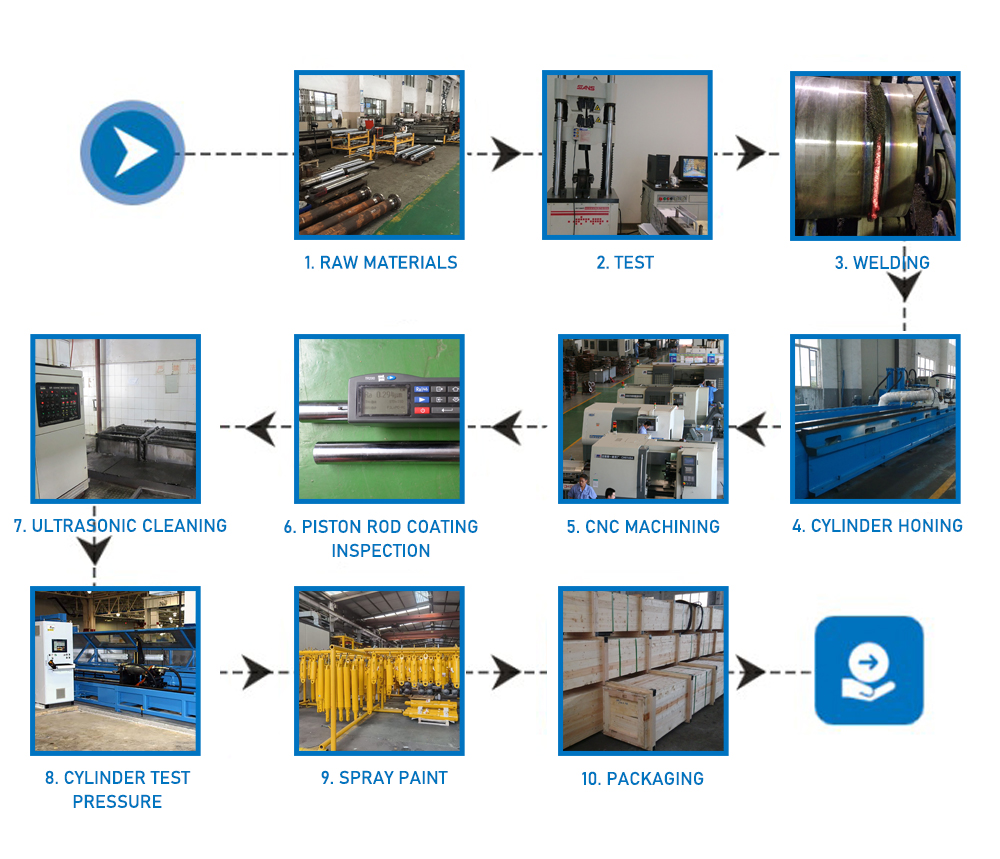01 Composition of hydraulic cylinder
The hydraulic cylinder is a hydraulic actuator that converts hydraulic energy into mechanical energy and performs linear reciprocating motion (or swing motion). It has a simple structure and reliable operation. When it is used to realize reciprocating motion, the deceleration device can be eliminated, there is no transmission gap, and the motion is stable, so it is widely used in various mechanical hydraulic systems. The output force of the hydraulic cylinder is proportional to the effective area of the piston and the pressure difference on both sides.
Hydraulic cylinders are usually composed of main parts such as the rear end cover, cylinder barrel, piston rod, piston assembly, and front end cover; There is a sealing device between the piston rod, the piston, and the cylinder barrel, the piston rod and the front end cover, and a dustproof device is installed outside the front end cover; in order to prevent the piston from hitting the cylinder cover when it quickly returns to the stroke end, the hydraulic cylinder end There is also a buffer device at the end; sometimes an exhaust device is also required.
02 cylinder assembly
The sealed cavity formed by the cylinder assembly and the piston assembly is subjected to oil pressure. Therefore, the cylinder assembly must have sufficient strength, high surface accuracy, and reliable sealing. The connection form of the cylinder and the end cover:
(1) Flange connection has a simple structure, convenient processing, and reliable connection, but it requires sufficient wall thickness at the end of the cylinder to install bolts or screw-in screws. It is a commonly used connection form.
(2) The half-ring connection is divided into two connection forms: the outer half-ring connection and the inner half-ring connection. The half-ring connection has good manufacturability, reliable connection, and compact structure, but weakens the strength of the cylinder. The half-ring connection is very common, and it is often used in the connection between the seamless steel pipe cylinder and the end cover.
(3) Threaded connection, there are two types of externally threaded connection and internally threaded connection, which are characterized by small size, lightweight, and compact structure, but the structure of the end of the cylinder is complicated. This type of connection is generally used to require small dimensions and lightweight occasions.
(4) The tie-rod connection has a simple structure, good manufacturability, and strong versatility, but the volume and weight of the end cap are large, and the pull rod will stretch and become longer after being stressed, which will affect the effect. It is only suitable for medium and low-pressure hydraulic cylinders with small lengths.
(5) Welding connection, high strength, and simple manufacture, but it is easy to cause cylinder deformation during welding.
The cylinder barrel is the main body of the hydraulic cylinder, and its inner hole is generally manufactured by precision machining processes such as boring, reaming, rolling, or honing. Sliding, so as to ensure the sealing effect and reduce wear; the cylinder must bear a large hydraulic pressure, so it should have sufficient strength and rigidity. The end caps are installed at both ends of the cylinder and form a closed oil chamber with the cylinder, which also bears a large hydraulic pressure. Therefore, the end caps and their connecting parts should have sufficient strength. When designing, it is necessary to consider the strength and choose a structural form with better manufacturability.
03 Piston Assembly
The piston assembly is composed of a piston, a piston rod, and connecting pieces. Depending on the working pressure, installation method, and working conditions of the hydraulic cylinder, the piston assembly has various structural forms. The most commonly used connection between the piston and the piston rod is a threaded connection and a half-ring connection. In addition, there are integral structures, welded structures, and taper pin structures. The threaded connection is simple in structure and easy to assemble and disassemble, but generally requires a nut anti-loosening device; the half-ring connection has high connection strength, but the structure is complex and inconvenient to assemble and disassemble. Half-ring connection is mostly used on occasions with high pressure and high vibration.

Post time: Nov-21-2022


